This post may contain affiliate links. Please read my privacy policy.
Drunken Noodles (or Pad Kee Mao) is a spicy Thai stir-fry with rice noodles, Thai basil, and aromatic spices. Despite the name, there's no alcohol in this flavorful dish. It’s a delicious blend of spicy, sweet, and savory flavors, making it a beloved Thai street food.
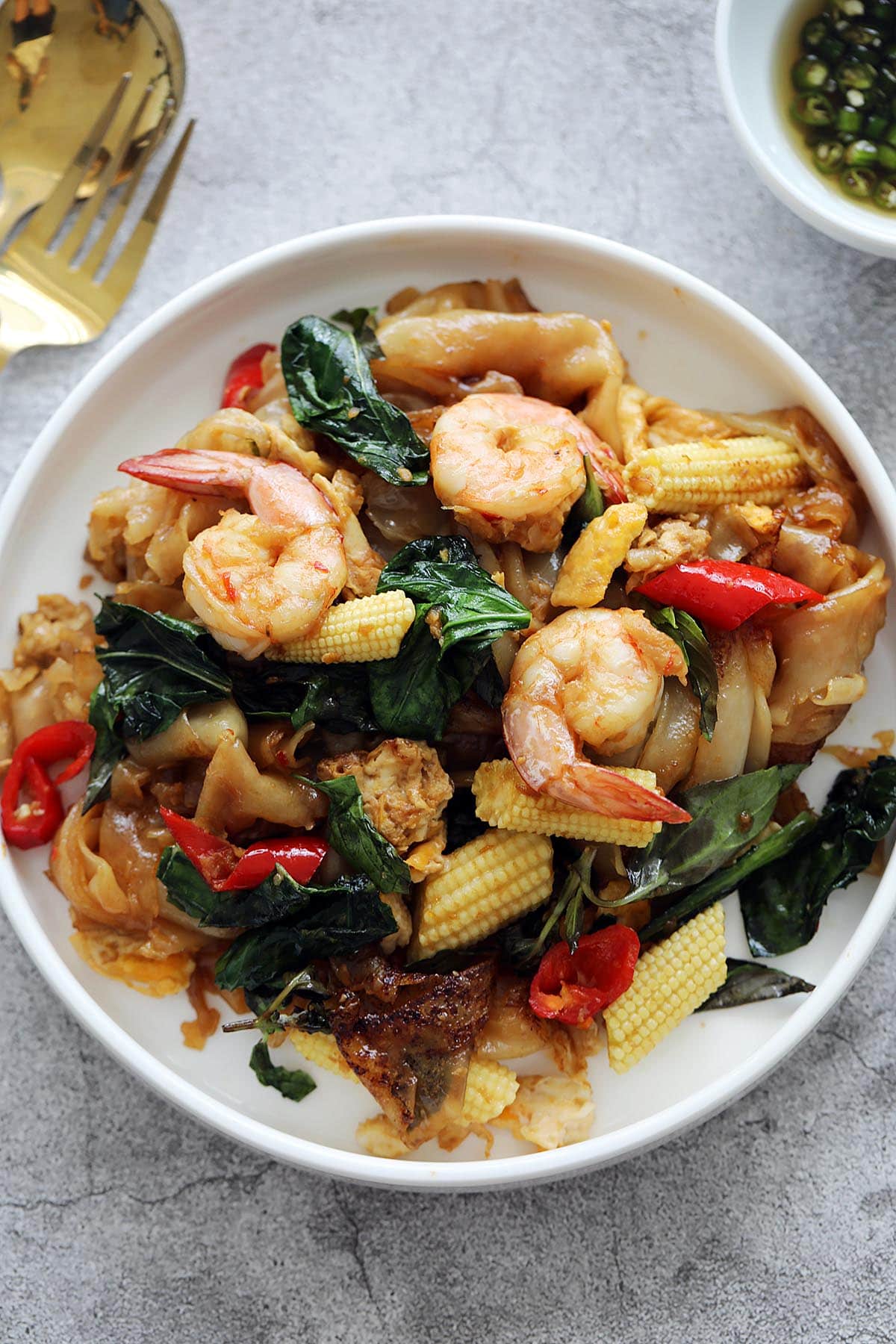
Pad Kee Mao
What are Thai Drunken Noodles?
Drunken Noodles, or Pad Kee Mao (ผัดขี้เมา) in Thai, are a popular street food known for their bold and spicy flavors. The name itself literally means “drunkard’s stir-fry” in English. “Pad” means stir-fry, and “Kee Mao” translates to drunkard or drunken. The dish is especially popular among those who have had a few drinks, as its spicy and flavorful profile is said to be perfect for a post-drinking meal.
Interestingly, according to She Simmers, a Thai cookbook author, Pad Kee Mao originally referred to a meat-based stir-fry without noodles. Over time, flat rice noodles, or kuay tiaw, were added to the dish, leading to its current, more popular version. Technically, Kuay Tiaw Pad Kee Mao evolved into the Drunken Noodles or Pad Kee Mao we know today.
Love Thai recipes? Check out my Tom Yum, Thai Red Curry, and Thai Cucumber Salad next. They are all amazing and taste just like the ones in Bangkok!
Drunken Noodles Recipe
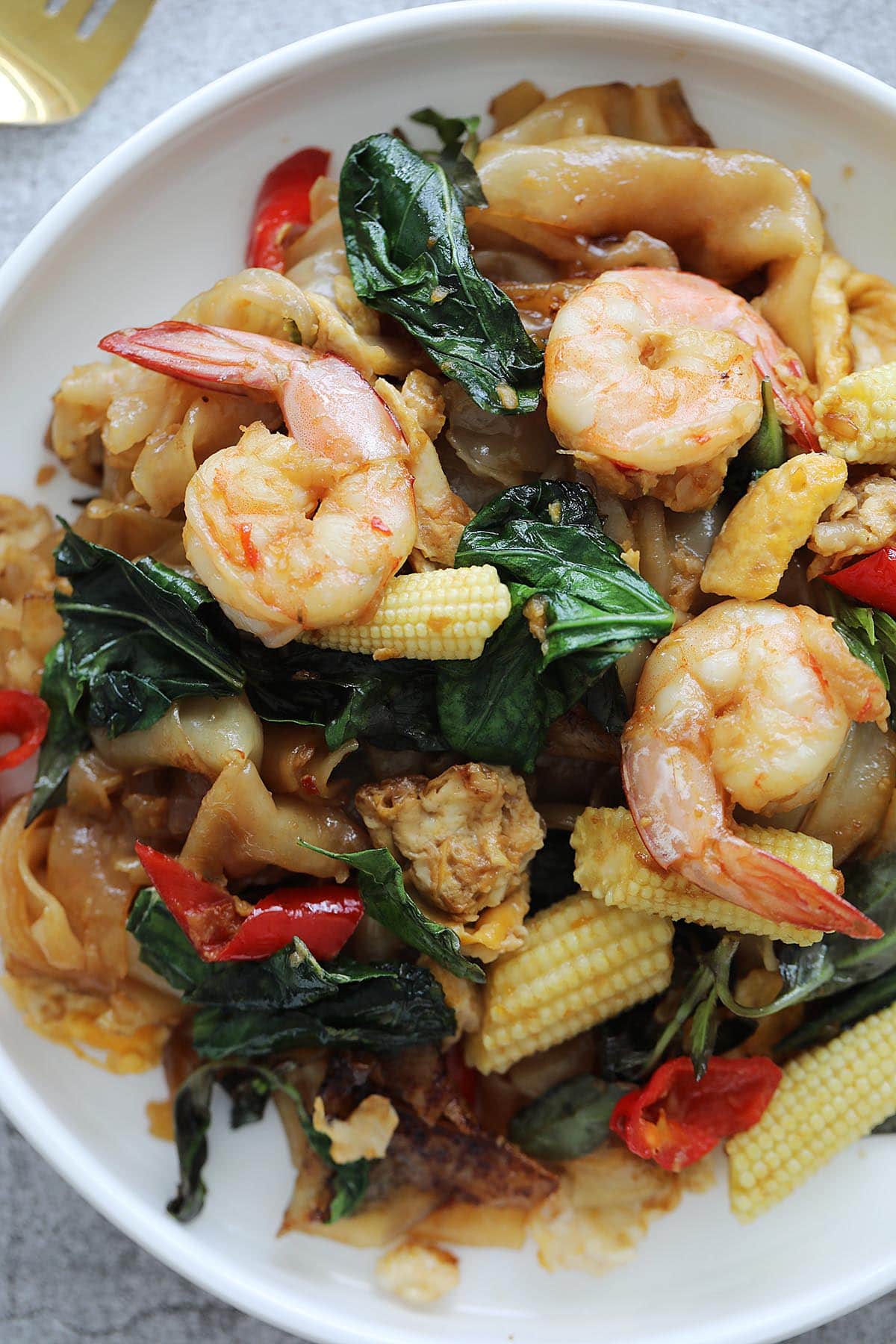
The Drunken Noodles recipe is essentially Pad Krapao or Thai basil chicken stir-fried with flat rice noodles.
In this dish, rice noodles are cooked in a hot wok with chicken and/or shrimp, along with vegetables like gailan (Chinese kale or mustard greens), Thai basil, baby corn, straw mushrooms, and young green peppercorns. Garlic and chili peppers are the main aromatics. The noodles are stir-fried over intense wok heat with a sauce made from fish sauce, oyster sauce, and other flavorful seasonings.
Pad Kee Mao has a savory taste with a slight sweetness and a spicy kick, while the basil adds a fresh, peppery flavor. Trust me, it’s a dish you won’t forget!
Recipe Substitutions
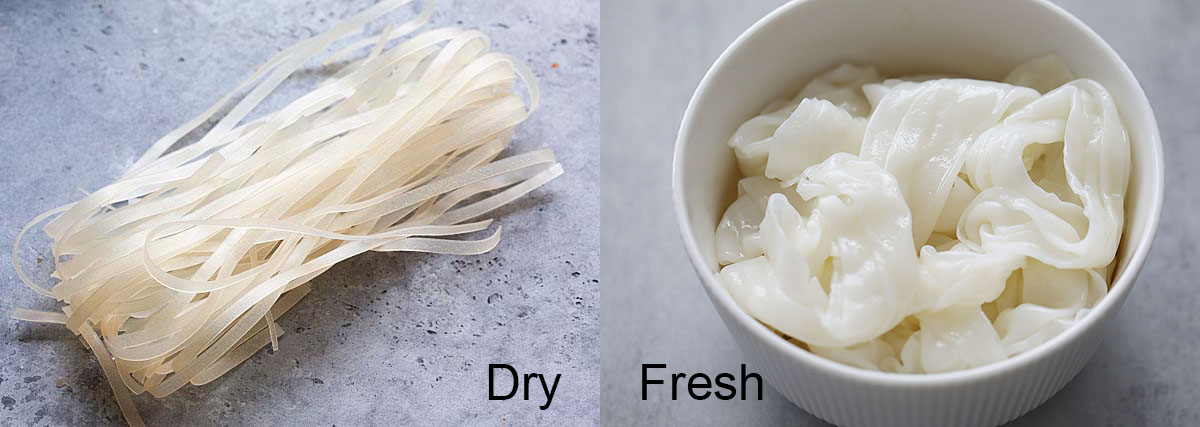
Dry wide rice stick noodles and fresh kuay tiaw are both popular in Thai cuisine but differ significantly.
Dry rice stick noodles are pre-cooked, then dried, requiring soaking before use. They have a chewy texture and are commonly used in stir-fries and soups.
In contrast, fresh rice noodles or kuay tiaw are soft and pliable straight from the package, offering a more tender texture and often used in dishes like Pad See Ew, Pad Thai and Rad Na.
Shopping Guide: In the United States, you can find dry rice stick noodles at Chinese and Asian food stores or online. Fresh rice noodles can also be purchased at Whole Foods; look for the Nona Lim brand’s fresh Pad See Ew noodles for your recipes.
Holy Basil vs. Thai Purple Basil
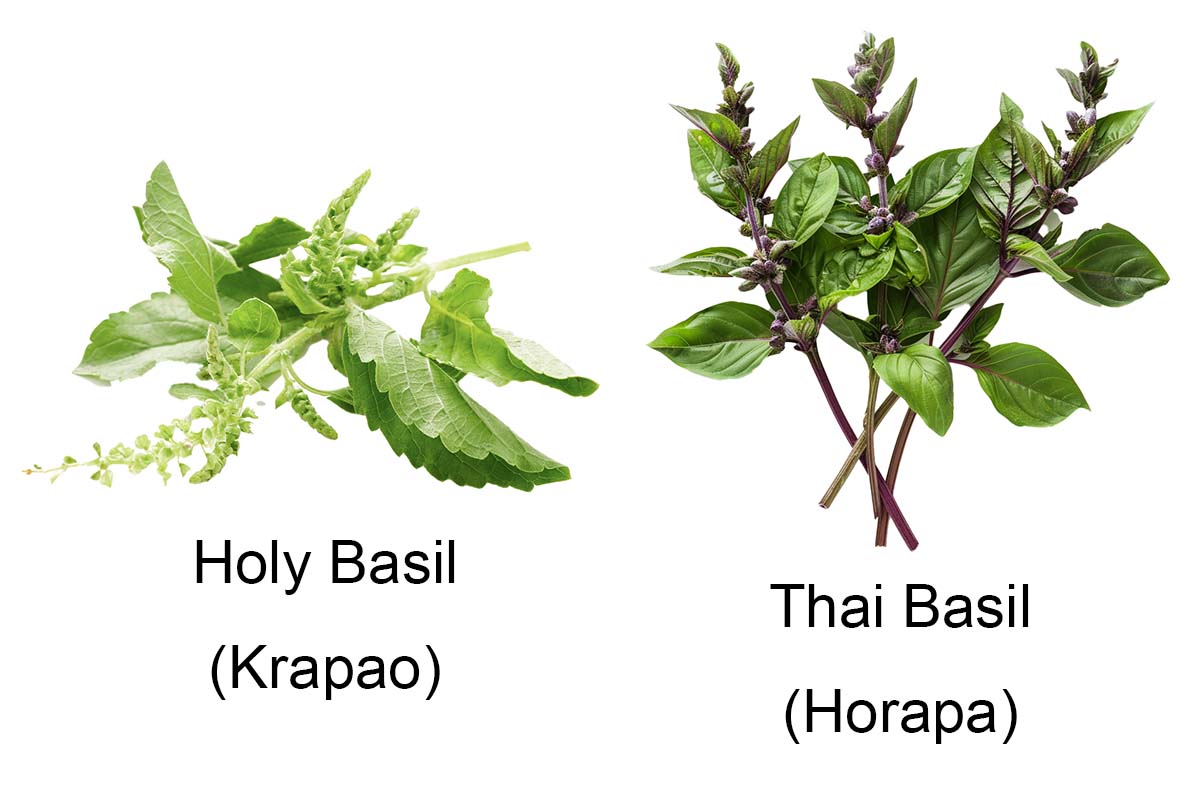
For authentic Pad Kee Mao, you should use Thai holy basil. However, it can be quite scarce outside of Thailand. If you live in the United States, you can use the purple-stem Thai basil available at Asian supermarkets.
If you’re fortunate enough to be in Thailand, you can find the “real” Thai holy basil at local wet markets or grocery stores. For your convenience, I’ve included a photo above for easy reference!
Shopping Guide: If you live in central or northern California, you might be in luck when it comes to finding Thai holy basil. Check out Hmong farmers’ markets in the area, as they often carry a variety of fresh herbs, including Thai holy basil. These markets can be a great resource for authentic ingredients and might offer a more extensive selection than traditional grocery stores. It’s worth visiting these markets if you’re looking to make an authentic Pad Kee Mao with the genuine flavor of Thai holy basil.
Drunken Noodles Ingredients
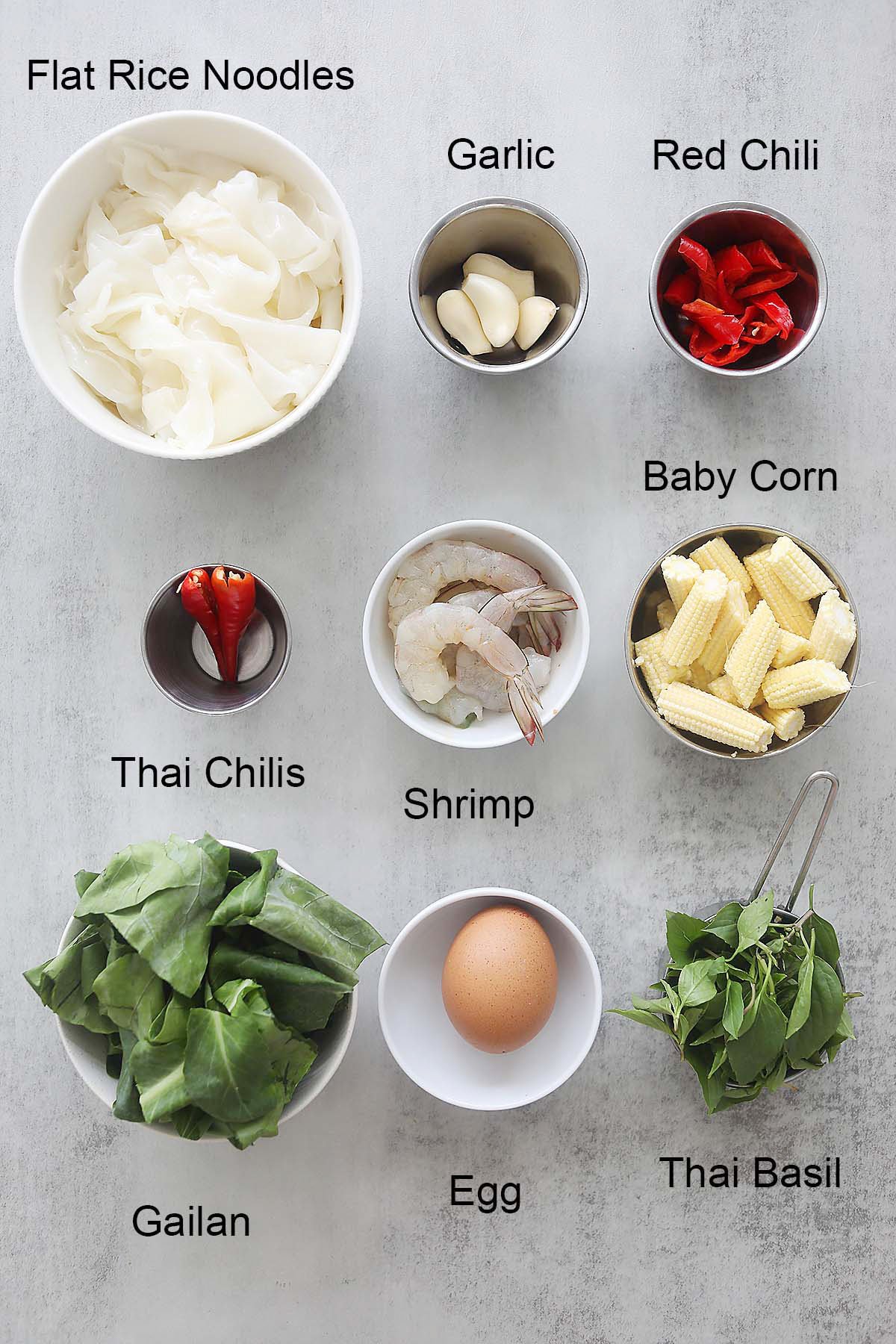
I developed this recipe after trying countless Pad Kee Mao dishes in Bangkok, including the renowned Michelin-starred Raan Jay Fai. I’ll show you how to cook drunken noodles like a pro, with flavors that transport you straight to Thailand!
- Rice Noodles (Kuay Tiaw): These flat noodles made from rice flour are the main ingredient in the drunken noodles dish. For this recipe, I used fresh rice noodles.
- Chicken and Shrimp: I used both in my recipe. If you prefer Pad Kee Mao Talay, or the seafood version, you can use a combination of shrimp, squid, and cuttlefish.
- Thai Chilies and Red Chilies: These chilies add depth and vibrant heat to the dish. Adjust the amount of Thai chilies based on your preferred spice level.
- Holy Basil or Thai Basil: These aromatic herbs provide a slightly sweet and peppery flavor, giving the noodles a fresh and fragrant kick.
- Gailan: Also known as Chinese kale, gailan is a leafy green vegetable with a slightly bitter taste and tender texture.
- Baby Corn
- Egg: Optional, for additional richness and texture.
Drunken Noodles Sauce
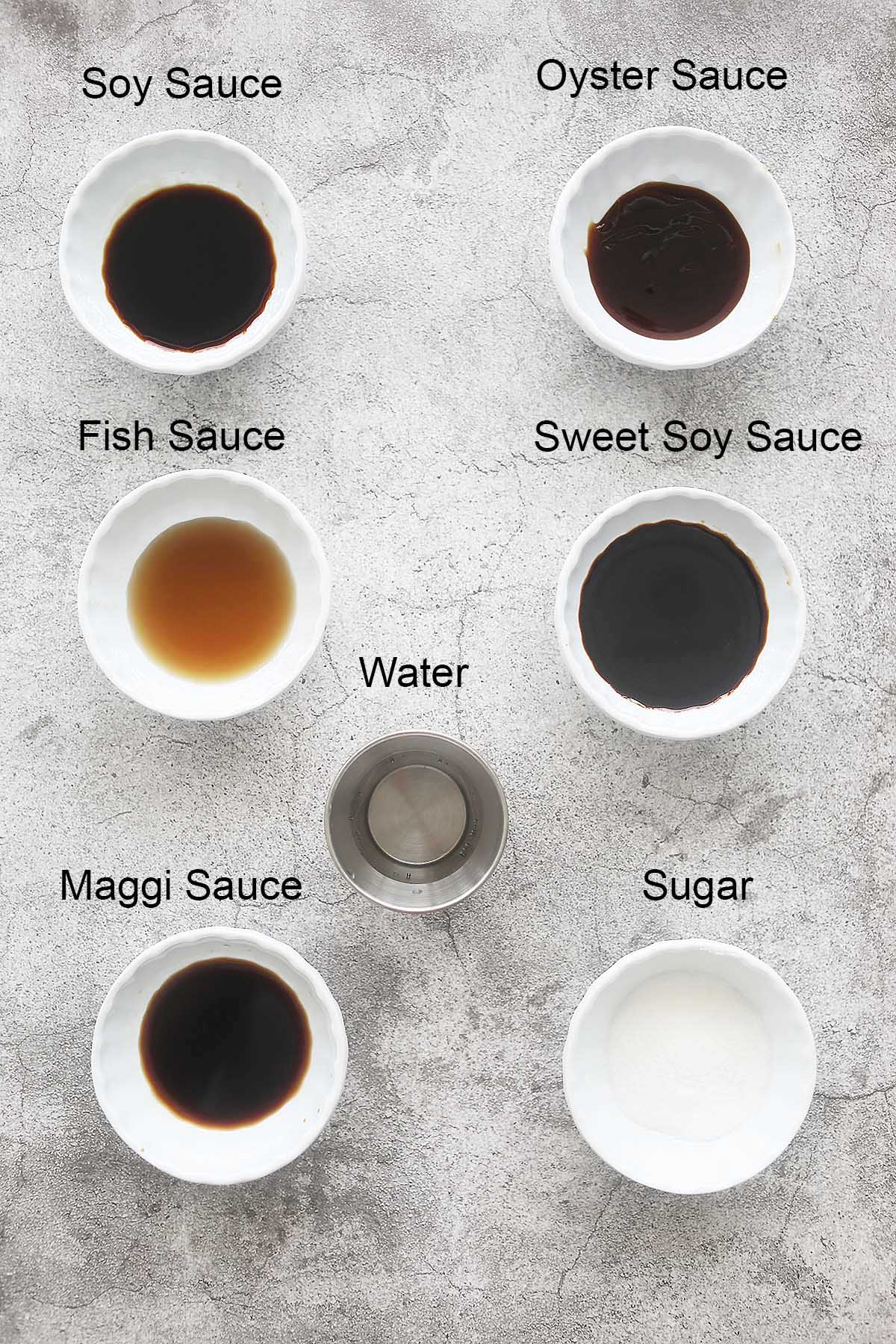
Here are the ingredients for the sauce:
- Soy sauce
- Oyster sauce
- Fish sauce
- Sweet soy sauce
- Maggi sauce or Golden Mountain Seasoning Sauce
- Sugar
- Water
How to Make The Best Pad Kee Mao
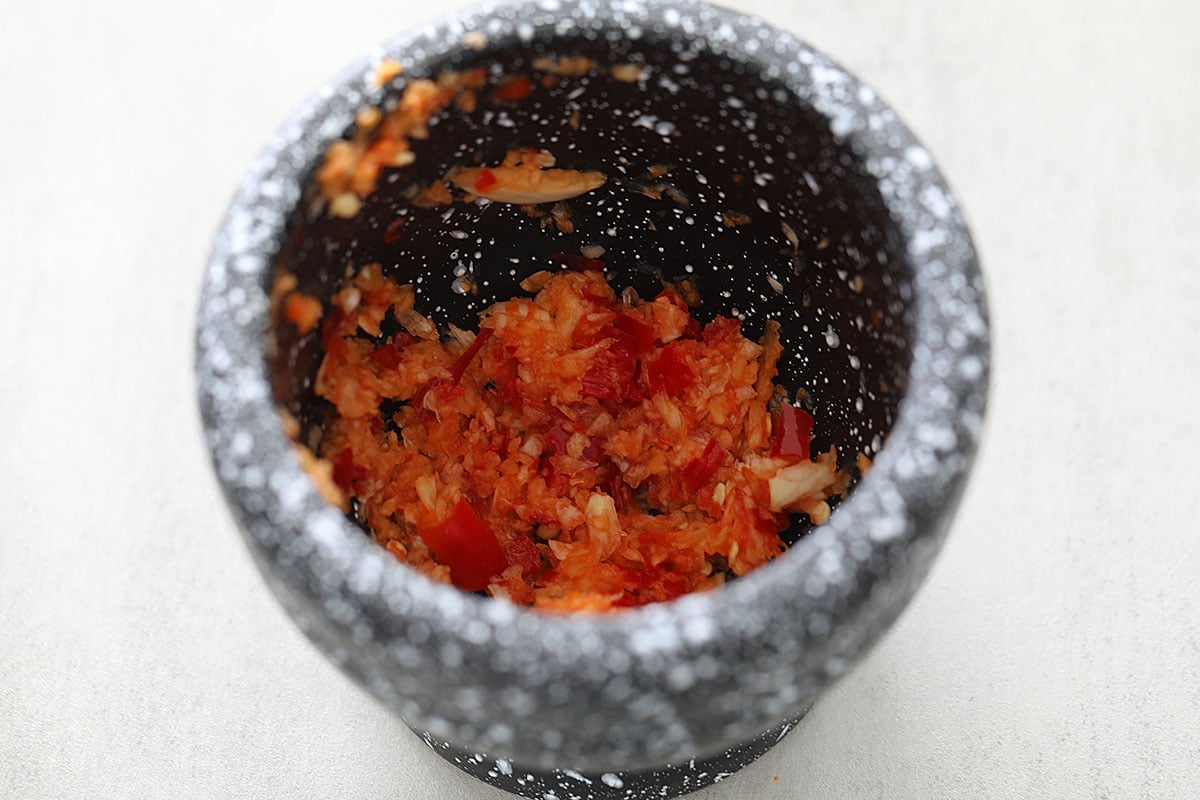
Step 1: In a mortar and pestle, pound the garlic and Thai chilies until they form a coarse paste.
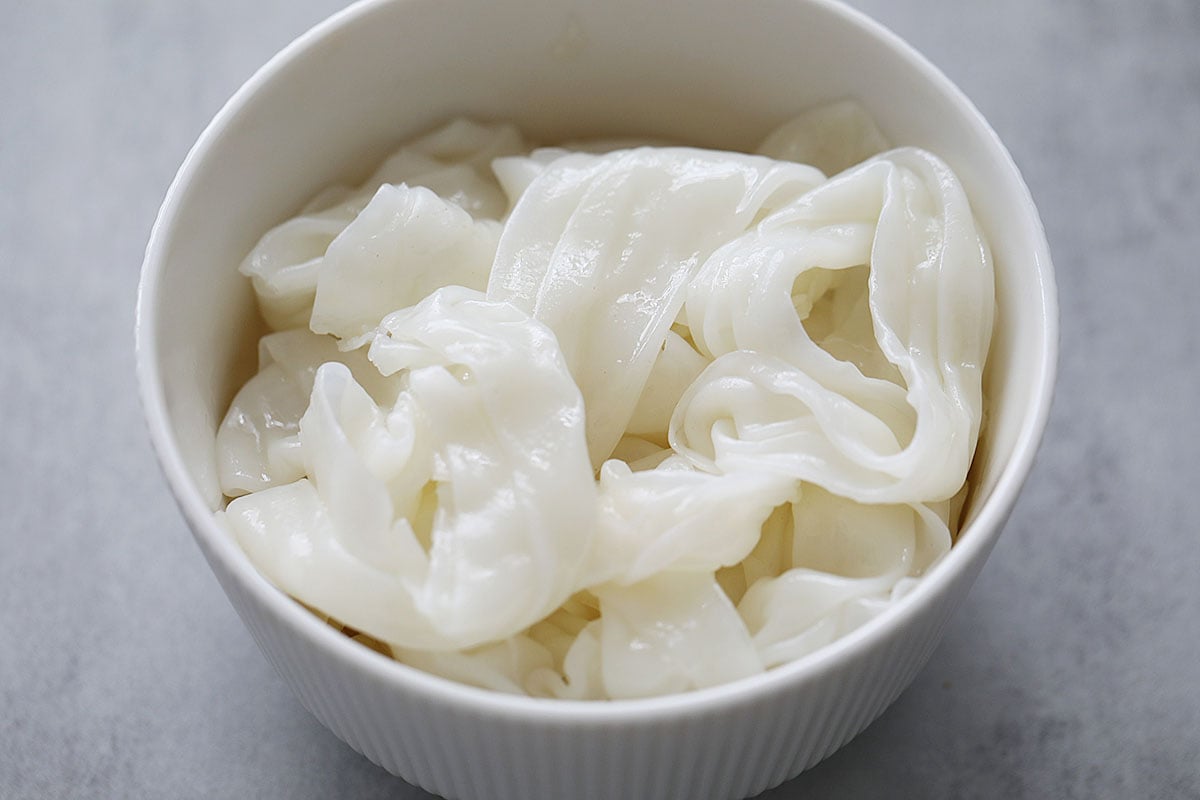
Step 2: Gently loosen the fresh rice noodles by hand, ensuring they remain separate and don’t clump together. If you’re using dry rice stick noodles, cook them according to the package instructions. Drain them in a colander and set them aside.
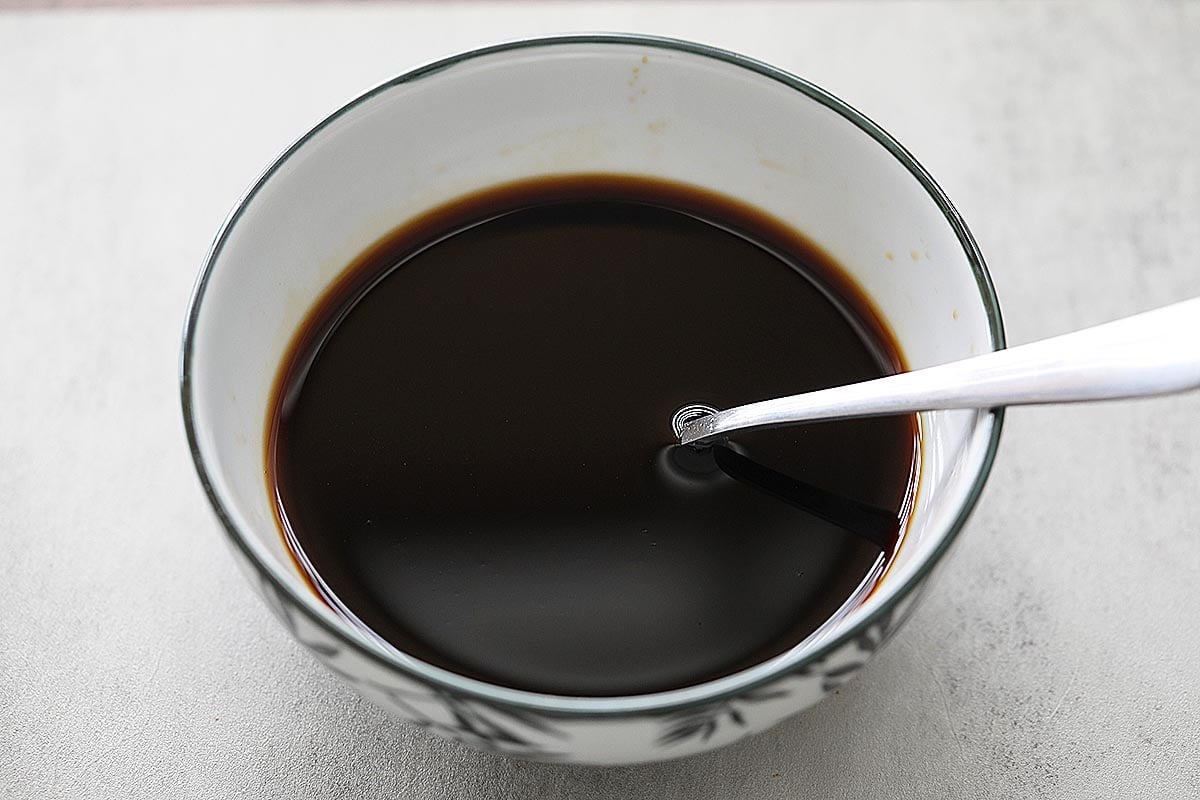
Step 3: Combine all the ingredients for the sauce in a bowl and stir to mix well. Set it aside.
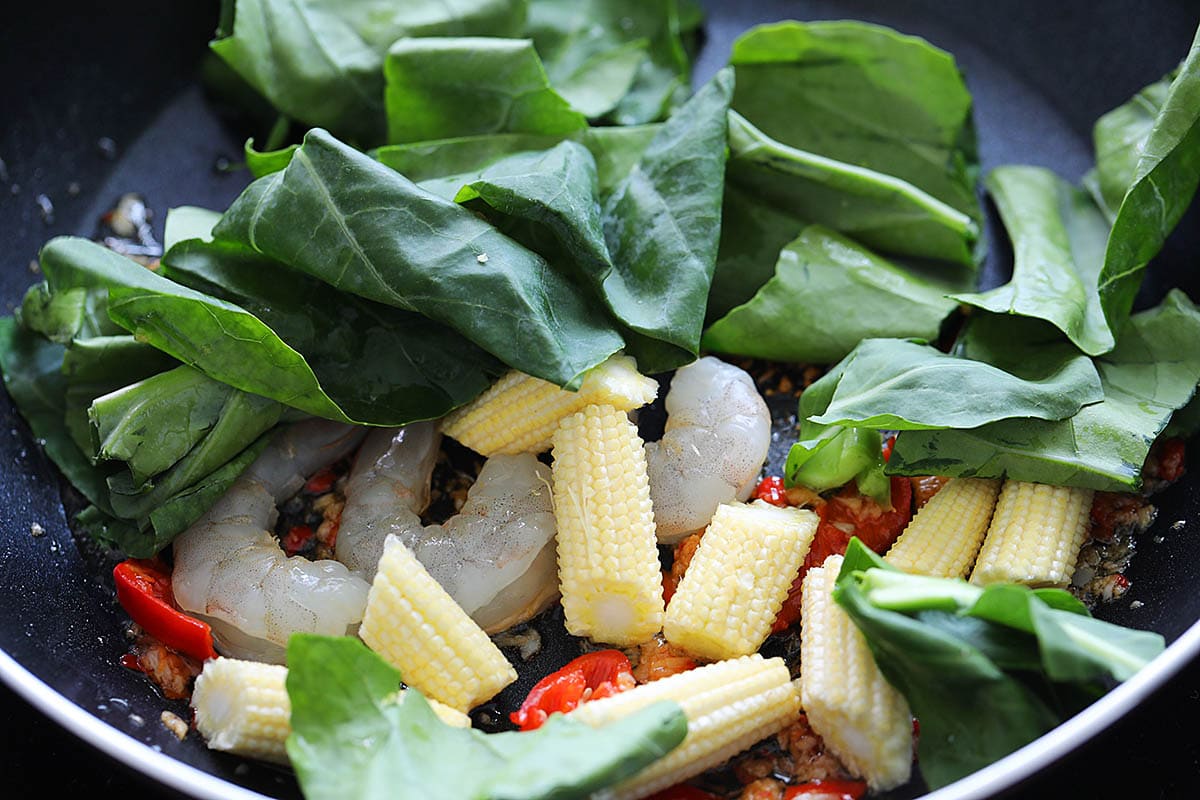
Step 4: Heat a wok or skillet with the oil. Add half of the pounded garlic and Thai chilies, along with half of the red chili, stir-fry until aromatic. Add the shrimp and cook until the surface turns white. Then add the baby corn and gai lan, stir to combine well.
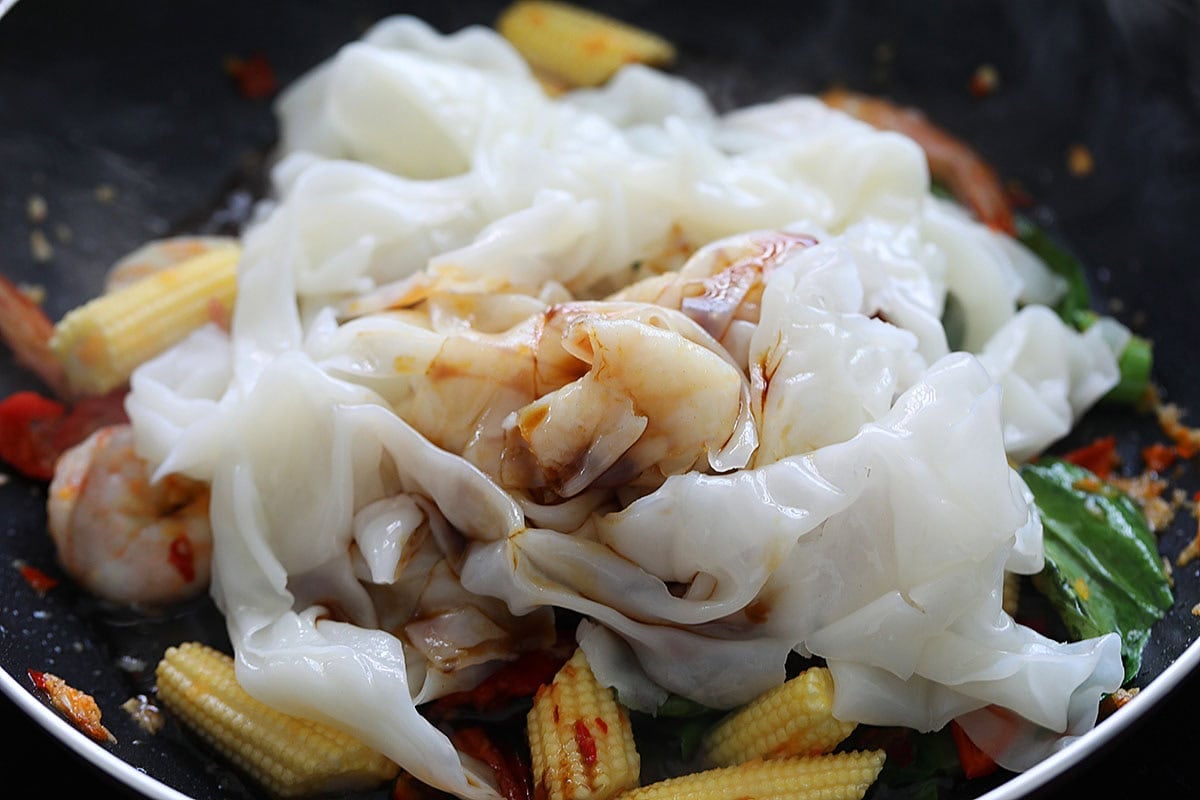
Step 5: Add a portion of the rice noodles and stir to combine them well with the ingredients in the wok. Pour in half of the sauce and stir to evenly coat the noodles, ensuring they are well-colored.
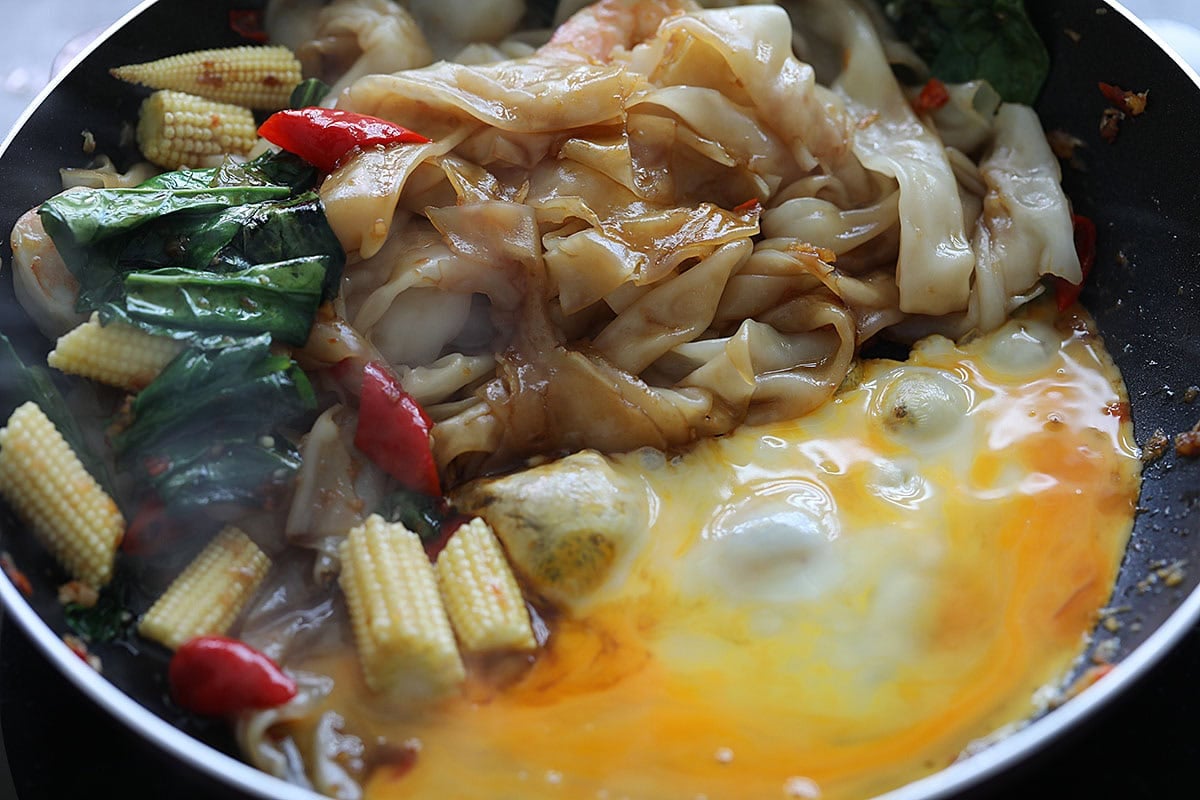
Step 6: If using eggs, push the noodles to one side of the wok. Add half of the beaten egg to the empty side, and as soon as the egg starts to set, stir it continuously with the rice noodles.
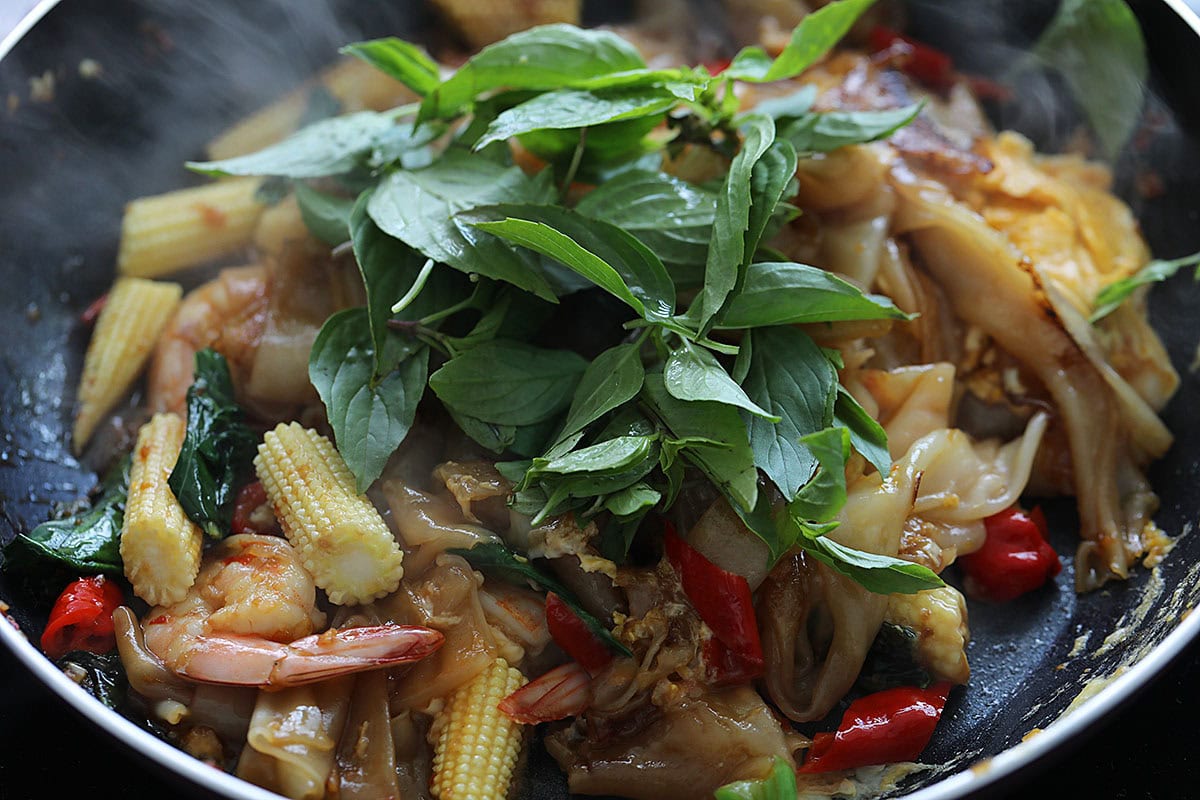
Step 7: Add the basil leaves and stir quickly to combine them well with the noodles.
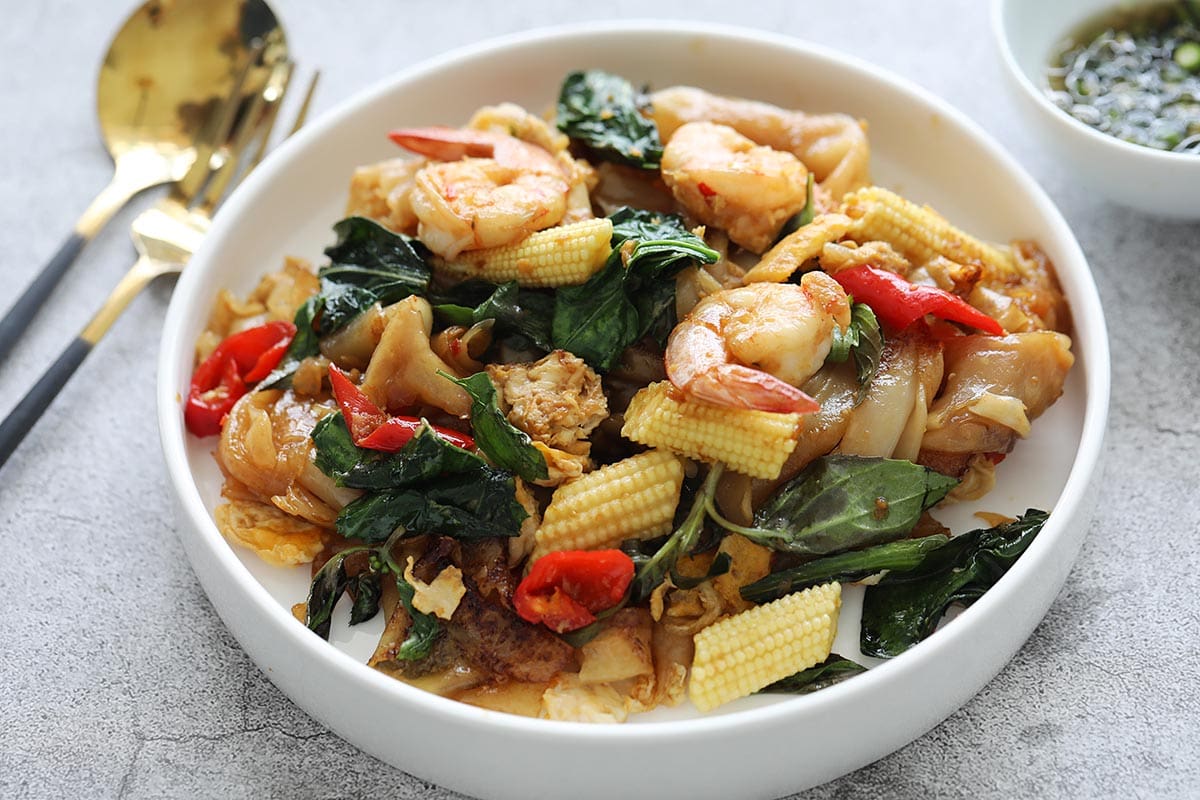
Step 8: Turn off the heat, and serve immediately.
Helpful Cooking Tips
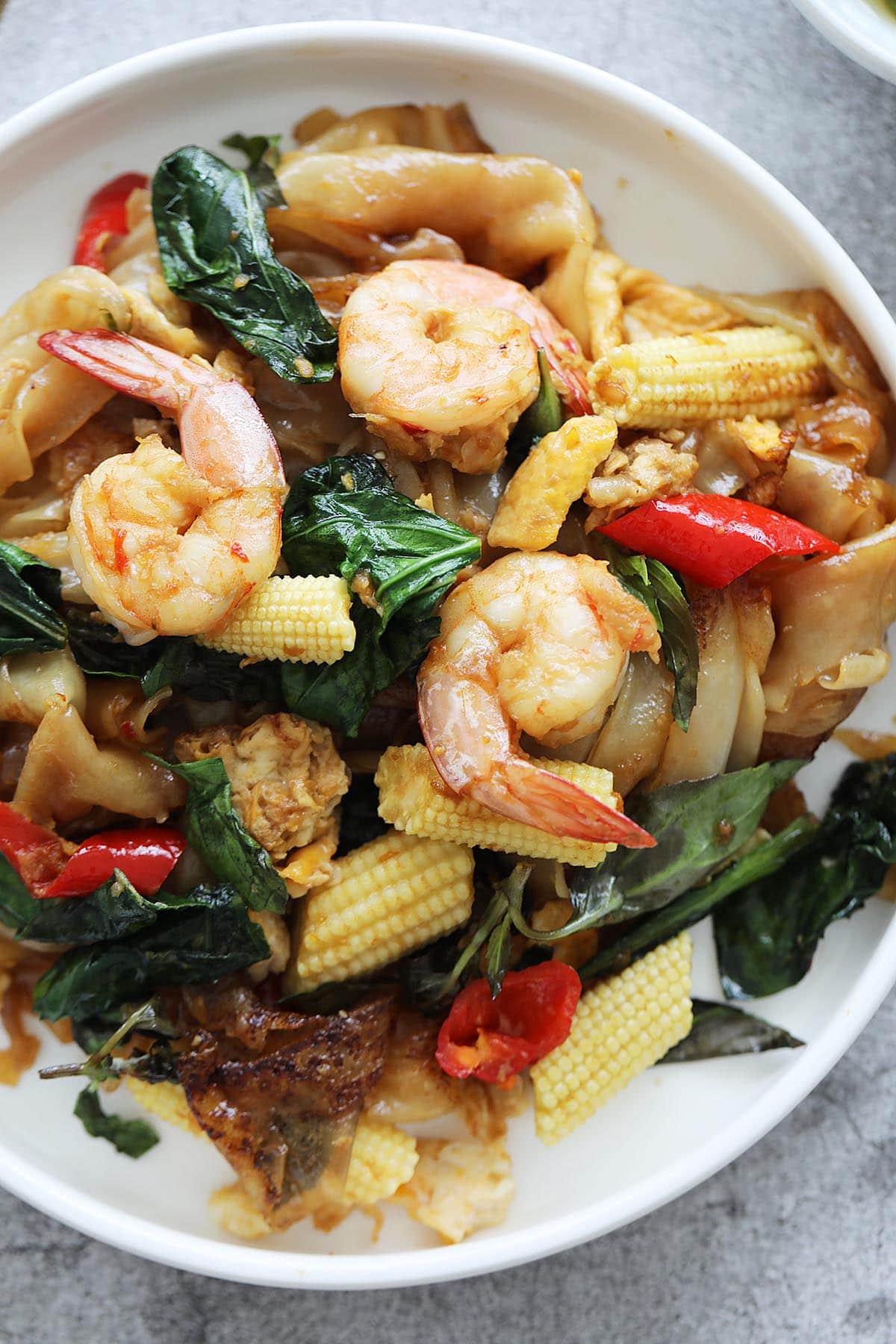
- To achieve that perfect balance of textures and flavors, it’s crucial to ensure all our ingredients are evenly heated for proper browning and stir-frying. Keep a close eye on everything as it cooks to prevent anything from becoming overcooked or undercooked. With a little attention to detail, you’ll have a batch of mouthwatering drunken noodles in no time!
- Jay Fai’s Pad Kee Mao Talay (seafood Pad Kee Mao) is next-level amazing. The wok hei—also known as the “breath of the wok”—adds a smoky flavor and perfect sear to the dish. Here’s the secret: get your pan or wok super hot before adding the ingredients. That intense heat makes the flavors pop and gives you the mouthwatering texture you crave.
Pro Tip: Prepare all your ingredients in advance and have them ready before you start cooking. This helps you add each ingredient quickly, ensuring even cooking and the best flavor and texture. It also helps maintain the wok hei, or smoky flavor, by preventing overcrowding in the pan.
Frequently Asked Questions
To get the best texture, soak the rice noodles according to the package instructions until they are just soft but not mushy.
Yes, you sure can. In fact, I once had Pad Kee Mao made with instant noodles at a popular Bangkok eatery, and it was delicious!
This recipe is only 798 calories per serving.
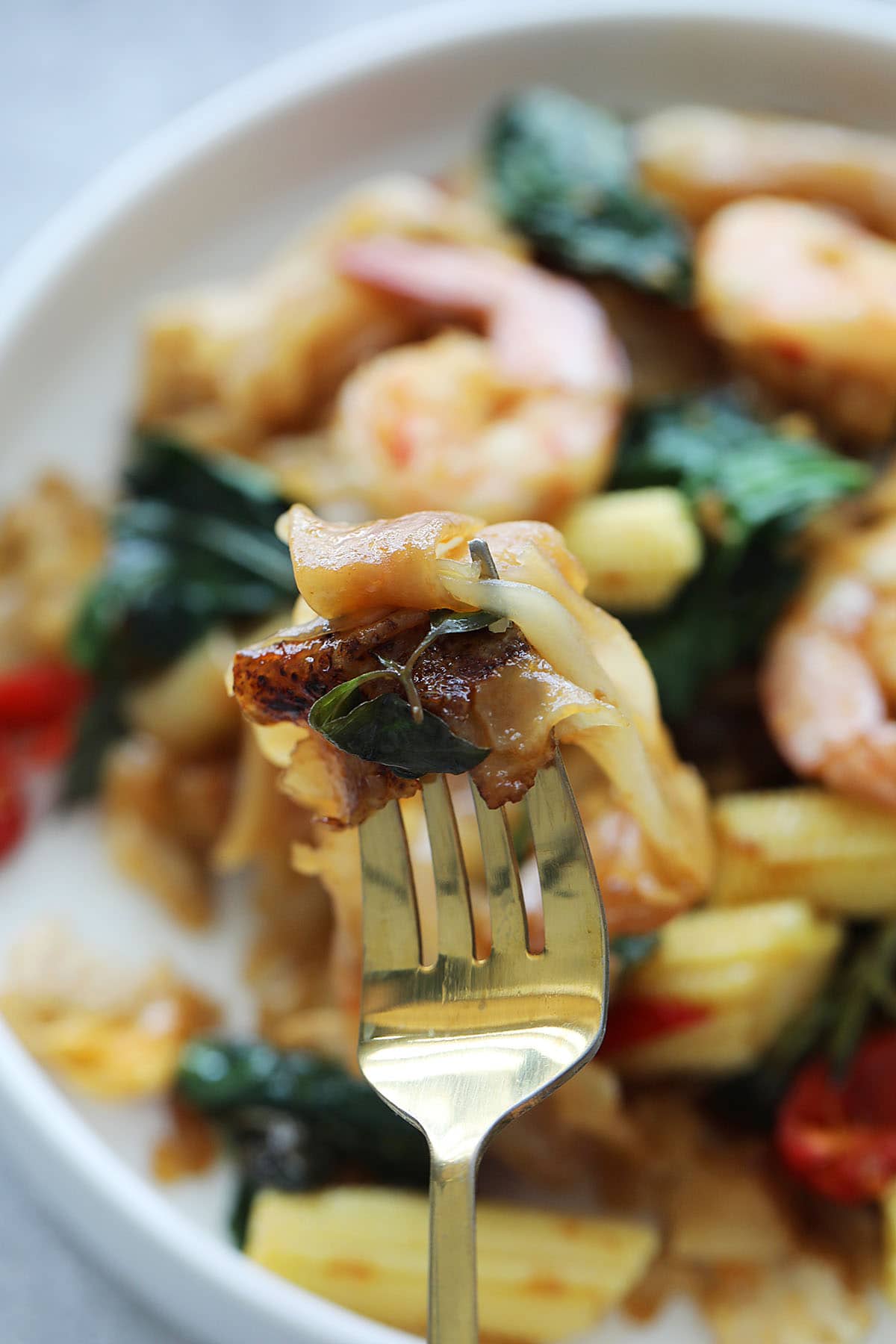
What To Serve With Drunken Noodles
Drunken Noodles are a complete meal on their own, but they pair well with a side of steamed rice, a fresh salad, or other Thai dishes. To impress your family and friends with your newfound flair in Thai cooking, I recommend the following recipes to complement the noodles.
I hope you enjoy this post as much as I do. If you try my recipe, please leave a comment and consider giving it a 5-star rating. For more easy and delicious recipes, explore my Recipe Index, and stay updated by subscribing to my newsletter and following me on Facebook, Pinterest, and Instagram for new updates.
Other Recipes You Might Like

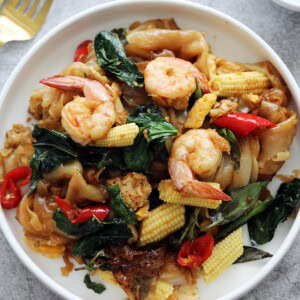
Drunken Noodles Recipe
Ingredients
- 4 cloves garlic
- 3 Thai chilies, red preferred
- 20 oz. (600g) fresh wide rice noodles, or 8 oz (230g) dry rice stick noodles, divide into two equal portions
- 4 tablespoons oil
- 1 – 2 fresh red chili, sliced into thick pieces
- 3 oz. (80g) medium-sized shrimp, 6 shrimp, shelled, deveined. tail-on
- 3 oz. (80g) baby corns, cut into halves
- 3 oz (60g) gailan, Chinese kale, cut into pieces
- 2 eggs, beaten, optional
- 1/2 cup holy basil , or Thai basil, packed, use only the leaves
Instructions
- In a mortar and pestle, pound the garlic and Thai chilies until they form a coarse paste.
- Gently loosen the fresh rice noodles by hand, ensuring they remain separate and don't clump together. If you're using dry rice stick noodles, cook them according to the package instructions. Drain them in a colander and set them aside.
- Combine all the ingredients for the Sauce in a bowl and stir to mix well. Set it aside.
- Heat a wok or skillet with the oil. Add half of the pounded garlic and Thai chilies, along with half of the red chili, stir-fry until aromatic. Add the shrimp and cook until the surface turns white. Then add the baby corn and gai lan, stir to combine well.
- Add a portion of the rice noodles and stir to combine them well with the ingredients in the wok. Pour in half of the sauce and stir to evenly coat the noodles, ensuring they are well-colored.
- If using eggs, push the noodles to one side of the wok. Add half of the beaten egg to the empty side, and as soon as the egg starts to set, stir it continuously with the rice noodles.
- Add the basil leaves and stir quickly to combine them well with the noodles.
- Turn off the heat, and serve immediately.
Video
Notes
- To achieve that perfect balance of textures and flavors, it’s crucial to ensure all our ingredients are evenly heated for proper browning and stir-frying. Keep a close eye on everything as it cooks to prevent anything from becoming overcooked or undercooked. With a little attention to detail, you’ll have a batch of mouthwatering drunken noodles in no time!
- Jay Fai’s Pad Kee Mao Talay (seafood Pad Kee Mao) is next-level amazing. The wok hei—also known as the “breath of the wok”—adds a smoky flavor and perfect sear to the dish. Here’s the secret: get your pan or wok super hot before adding the ingredients. That intense heat makes the flavors pop and gives you the mouthwatering texture you crave.
- Prepare all your ingredients in advance and have them ready before you start cooking. This helps you add each ingredient quickly, ensuring even cooking and the best flavor and texture. It also helps maintain the wok hei, or smoky flavor, by preventing overcrowding in the pan.
Nutrition
Nutrition information is automatically calculated, so should only be used as an approximation.
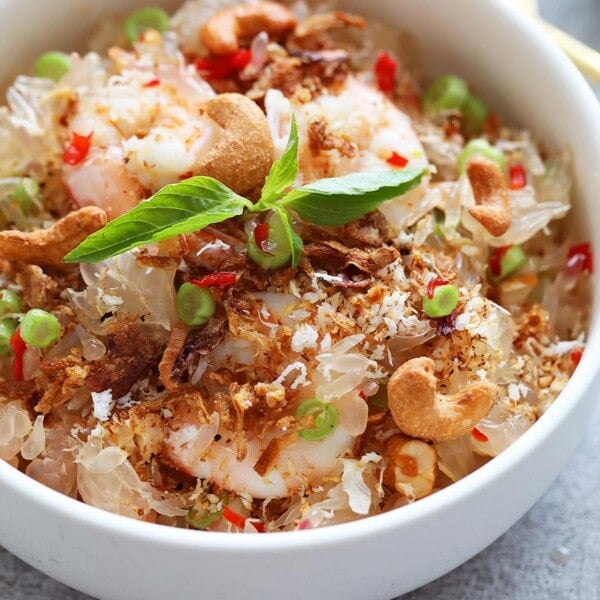
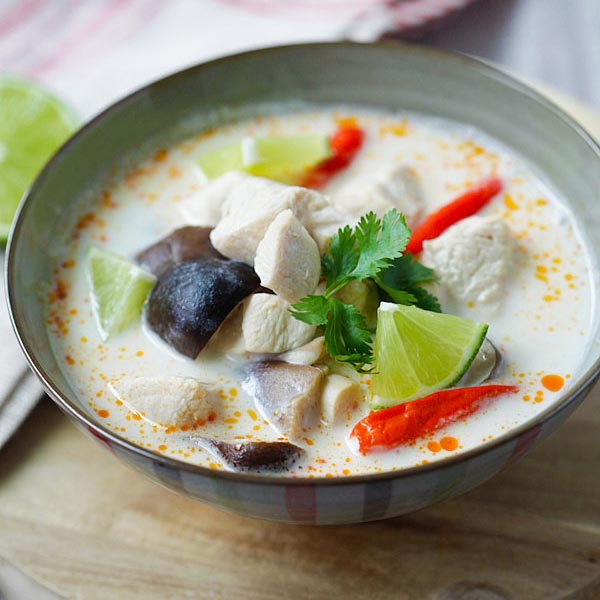
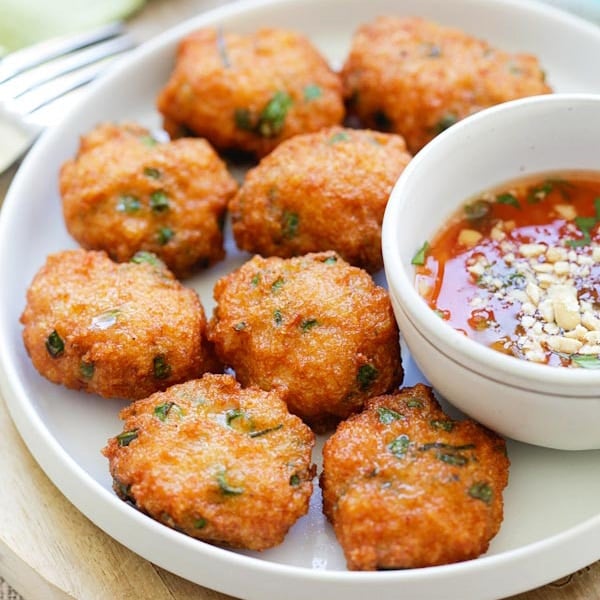
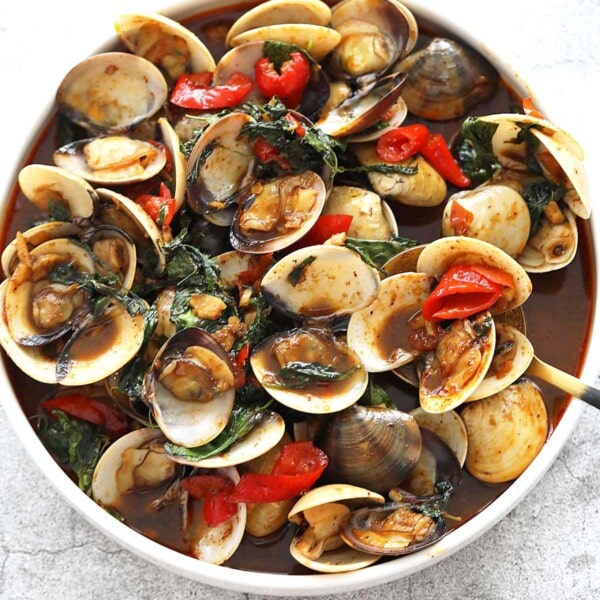






If Jay Fai is the wonderful small restaurant on Sai Yuan in Phuket, this is, MOST assuredly, a wonderful recipe! I’m going to be making this for company in 6 days. Yummers!
Hi Wandee. Awesome, thanks for trying my recipe. Please try more recipes on my site!
Bee, I i’ve tried so many of your recipes and I love them. How can I get your cookbook?
Hi Irma, my cookbook is called Easy Chinese Recipes. You can buy it on Amazon.com.
This recipe is so very delicious like most of the recipes on this website. The one problem is that it calls for “2 oz.” Thai basil leaves. So I set out to weigh out 2 ounces of Thai basil leaves until I noticed 2 ounces by weight of basil leaves was way too much. I find many recipes with ambiguous measures…weight or volume. Usually I have been able to figure this out…but not always and the recipe is ruined. So, my wish is that when measurements are posted please post them if they are volume or weight. I love your recipes. But please post measurements as weight or volume in cases where it is ambiguous. Thanks Bee!
Hi Daphne. Thank you for your comment. Usually liquid ingredients will be measured by volume, and all other ingredients by weight. 2 oz. or 56 gm of Thai basil leaves is correct.
I love this receipe, so easy to prep and cook. I only used half a green chilli, but my teenage kids could eat it, so worth the sacrifice! I bought a Woll wok, which did the job nicely. I have an Induction cook top, and a heavy wok is essential for stir frying with induction, because the heat turns off as soon as you lift the wok for tossing, etc. The Woll did a good job for this first outing, when cooking a small meal. I am yet to try it on a larger meal, but I am optimistic it will be fine.
Hi Tony, that’s great that you bought the Woll work and love this recipe. I am so happy that you tried, and please try more recipes on my site: https://rasamalaysia.com/recipe-index-gallery/
This recipe looks delicious! I am going to try it tonight. I do not have a wok but I will try my luck with a nonstick frying pain.
Wish me luck and thanks for the recipe!
Cindy Waldron
Hi Cindy, you should definitely invest in a non-stick wok in the near future. Woll Diamond Pro Lite Wok is what I use. :)
I accidentally used 2 T of the fish sauce and less basil and didn’t add tomatoes. I thought it was easy and fantastic!
That’s awesome, I am so glad you liked the drunken noodles. 2 tablespoons of fish sauce is fine, just give the noodles more flavors.
Can you freeze the left-overs and reheat at a later date
Yes, you can freeze the leftover and just microwave before eating.
Hello, Bee,
Would it be possible to fix the PRINT link? Most of the other highlighted words work but not the print button.
Thanks.
xxoxoox
The reason it is called Pad Kee Mao/Drunken Noodles is that the guys eat these after a night of drinking IE Mekong Whiskey! This has been a favourite dish of mine since I first learned to make it over 25 years ago during one of our trips to The Kingdom.
I highly recommend using Thai Oyster Sauce for best flavour, (picture of lady pouring oyster sauce into wok on label-red label www.tramaekrua.com ) no English name on bottle-I use for fried rice too.
I suggest using either Rice Vinegar or Chinese Black Vinegar in the sauce. Date Palm sugar gives softer sweetness in the balance. I prefer Thai Chiles or Serrano chiles for the non Metallica heat, red ripe best IMHO. I like a handful of cubed cabbage in this for nice texture, and if you have Holy Basil/bai gaprao if available and sliced pickled garlic for garnish. But never mind Pad Kee Mao is an awesome satisfying dish!
You put vinegar in the sauce ?